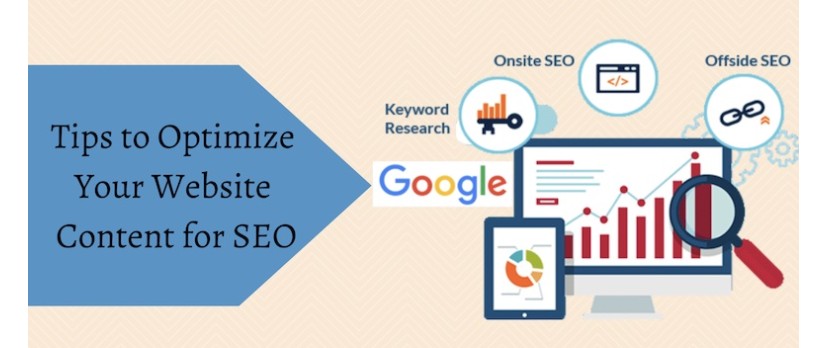Optimizing or tailoring your website content according to the guidelines of search engines is essential, if you want to experience higher rankings. The higher rankings will provide you with maximum user engagement – which is the primary goal of all websites on the internet.
You can find numerous guides on the internet discussing different ways to optimize your web content for SEO. However, in this article, I am going to discuss some easy yet effective ways through which you can optimize the content of your entire website according to the requirements of search engines.
How You Can Efficiently Optimize Your Web Content for SEO – Guide
Below are some ways that you need to follow in order to perfectly optimize your website content for Search Engine Optimization (SEO).
Perform keyword research:
Most of us will already know the importance of keywords for SEO. Keywords are basically specific words and phrases that describe what a particular content or website is about. When search engines like Google efficiently know what your site or content is about, they will rank it accordingly in the search results.
On the other hand, keywords also help users to find your content online. Whenever they search for a particular keyword on Google, they will be shown the most appropriate content/site that contains the searched keyword.
So, in order to optimize your website content for SEO, you load it up with the most relevant yet latest keywords. For this, you have to perform research. There are many tools such as Ahrefs or SEMrush or APIs like the Google Trends API that can also help you to find relevant and high-volume keywords related to your web content.
To ensure your keyword strategy is effective, consider consulting with experts like the Timmermann Group. They have a proven track record in helping businesses improve their SEO rankings through comprehensive keyword research and implementation.
After finding keywords, you should not brutally incorporate them blindly into the content, this will be considered keyword stuffing. Instead, you should add keywords strategically – where they are necessary.
Tip: In order to make the most of it, you should use keywords in the title, heading, content, descriptions, etc.
Optimize headings tags
Heading tags act as an information guide for search crawlers, allowing them to quickly crawl the entire content. Additionally, headings also provide an efficient idea of what going to be discussed in the content.
These also play a significant role in improving search visibility of the content and rank in order of importance from H1 to H6. So, to optimize your web content, you first have to optimize its heading tags. The procedure you need to follow for this is listed below:
Use H1 tag for title
Do not repeat the H1 tag and include the primary/focus keyword in it.
Make use of H2 & H3 tags to explain the subheading of content.
Keep the heading clear and concise.
Do not skip the heading tag like after using H2, do not use H4.
By taking care of all these, you can efficiently optimize the heading tags of the website content, and improve its overall rankings – the main purpose of SEO.
Make content user-friendly
Search engines like Google lives to serve the users. Due to this reason, they encourage to create and publish user-friendly content. User-friendly content here means content that helps users quickly find and understand the information they are reading.
When the readers or visitors both find and understand the information provided in your web content, they will spend more time on the webpage, resulting in a decreased bounce rate, and ultimately ranking.
Now the question here is how you can make content user-friendly. When you use heading tags in the website content, it will make it easier for the visitors to find the required information. When it comes to making content simple to understand, you need to put in some effort.
Incorporating heading tags and strategic keyword placement throughout your content can enhance both user experience and search engine visibility, ultimately fostering a stronger brand identity and driving engagement with your brand identity services.
You have to use words and phrases that are commonly known to average humans, instead of technical or complex jargon. Obviously, this will require time and effort because you have to simplify your entire website content. Along with this, it will also require strong writing skills, especially vocabulary.
So, if you don’t want to devote time and effort or lack vocabulary, then there is no need to worry. Because you can simply the web content with the help of a rewording tool. It quickly rewords the given content by replacing complex words and phrases with their simple synonyms.
Moreover, you also need to make use of bullets/numbering, tables, short sentences, and paragraphs to make the content user-friendly.
Add internal and external links:
To optimize your web content for SEO, you will need to add internal and external links to the content. This is an effective strategy that greatly helps in boosting the ranking power.
For instance, internal links are the links that redirect users from one webpage of a site to another, aiding search engine crawlers in finding and indexing all the relevant pages on your site. It is recommended to only add links of relevant content that provide value to the users. For example, platforms like Topstep, a top step prop firm, offer insightful content on trading that could be linked to as a valuable resource for readers interested in financial markets. This not only enhances the user experience by providing them with additional information but also helps in establishing the credibility of your website.
Internal links are the links that redirect users from one webpage of a site to another. These help search engine crawlers to find and index all the relevant pages on your site. However, to get the most out of internal links, it is recommended to only add links of relevant content. And always try to add links that provide value to the users.
When it comes to external links, they redirect the users from one page to a third-party website or page. These contribute more to ranking than internal links. This is so because, search engines like Google consider external links as third-party confidence votes. One thing you need to keep in mind is that you should only add external links to reputable and trusted sources.
So, when you build both internal and external links, it will boost the authority of your website, which will further result in improved rankings.
Add visuals to the content:
Adding visuals to the content also helps in optimizing web content. Visuals like infographics, images etc greatly help in grabbing the attention of the visitors as compared to plain text.
They encourage visitors to spend more time on your site. And when users spend more time on your site, it will result in increasing dwell time.
The increased dwell time of the site will give a positive indication to the search crawlers which will further result in improved ranking.
Additionally, using visuals in the content will help you to efficiently break the pattern of plain text, resulting in improved formatting.
However, it is important to note that, adding visuals will not be enough, instead, you also have to optimize them for SEO. For instance, if your web content contains images, then you can optimize them with the following approach.
Resize the pictures
Add alternative text, but keep it clear and concise.
Make pictures mobile-friendly.
Try adding captions.
So, this is how you can efficiently optimize the images according to the guidelines of search engines.
Final Words:
No matter how high-quality content you publish on your site; if it’s not optimized for SEO, it won’t be able to get your website to a high rank in the SERPs. In this blog post article, I have explained some of the simplest yet effective ways through which you can efficiently optimize your website content for SEO.


Login and write down your comment.
Login my OpenCart Account